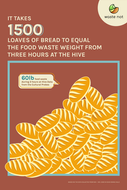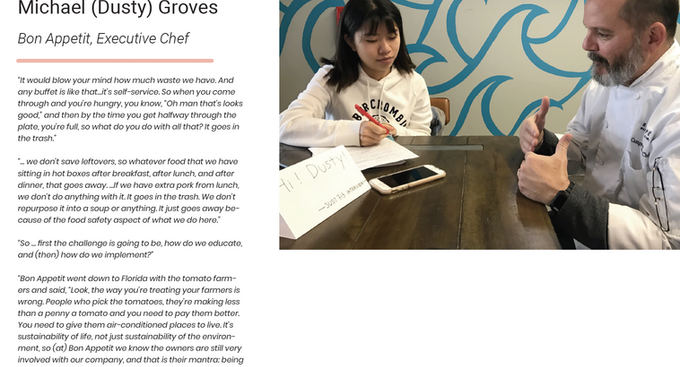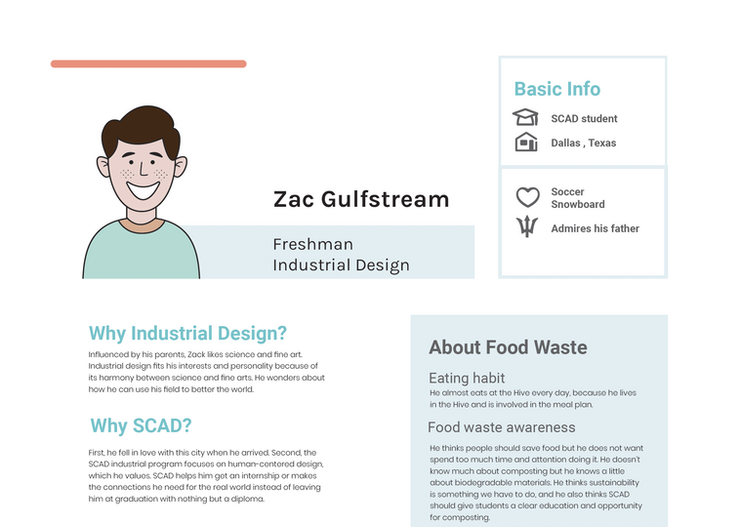
Waste Not
It is a sustainable nutrient system for college, aiming to educate students to save.
Client
SCAD
Net Impact
Bon Appetit
Duration
10 Weeks
Team
Mo Zhou, Wenjing Zhang, Yihui Wang, Yujia Zheng, Liu Ren, Shruti Nakar, Peizhi Han, Bryan Benson, Elena Webb, Jiaxin Li, Sarah Prifitera, Xiaoyin Zhang, Wanching Wang, Aurelio Velez, Beth Miller
Role
Research
Product Service System Design
Visual Design
Context
It is the dream of President Wallace to build a sustainable place for SCAD (Savannah College of Art and Design), where what would be wasted could be transformed into valuable. Just like SCAD’s mascot, the bee. They create no waste.
Inspired by the dream, SCAD has an initial plan to make use of food waste. Therefore, the college farm SCAD’s Back 40 works together with its partner Net Impact, Bon Appetit, to achieve a sustainable nutrient system.

SCAD's Back 40
SCAD’s Back 40 is the experiment farm of SCAD and is also the dream of President Wallace. It is a well-designed, sustainable space in which SCAD could grow food for campus and encourage student health. Currently, Back 40 is transforming from a farm to a community for students.

Net Impact
Net Impact is an international organization that connects university students to amplify their efforts as changemakers for a sustainable future. SCAD’s Net Impact chapter furthers Net Impact’s campaigns in Savannah.

Bon Appetit
Bon Appetit is SCAD’s award-winning food service provider. It notices the plenty of food waste from SCAD dining halls and already works with local farms interested in renewing the salinized clay in the Savannah area.
Challenge
On the one hand, as one of the largest art colleges with four campuses and dozens of dining halls, SCAD's amount of food waste is stunning and hard to control. The colleagues from Bon Appetit (the food service provider of the Hive) have always been keeping an eye on the leftovers and trying multiple ways to control the food waste. However, the effect is rare to see.
On the other hand, SCAD's Back 40 is relatively new to most SCAD students, and it seldom worked with dining halls before. Therefore, both the collaboration mode and sustainable education need to be explored.

Leftovers in the Hive (One of SCAD’s dining hall)
How can we propose an achievable, sustainable system that connects to the current food supply system and every SCAD student?
Design

Redesign of college farm
Design of nutrient flows
Product-Service System
Check here
System Map
SCAD's Back 40 Site Map
(Composting Facilities & Visitor Center)

Food saving and composting education for freshman
Awareness Campaign
Check here
Freshman Experience
Poster Design
Social Media
Product-Service System Map
This product-service system map illustrates the proposed SCAD food management system, including all construction and material flows between multiple locations There are seven main locations in the system, including The Hive, SCAD Back 40, the anaerobic digestion facility, in-vessel composting facility, market, equestrian center, and sports field.
The food management system at SCAD starts with the largest SCAD cafeteria, The Hive. Food waste in The Hive is collected and separated. The front-of-house waste, which is post-consumer food waste, is used in the anaerobic digestion system. Some of the food scraps from the back-of-house, like carrots, can be used for horse feed, while the rest of the leftovers will be suitable for in-vessel composting or anaerobic digestion.
All the food waste is transported by SCAD electric trucks powered by energy from the on-site anaerobic digesting (AD) processes. The anaerobic digestor can compost any materials that should be limited with in-vessel composting, such as meat and dairy. In addition to producing fertilizer, AD also produces methane as a by-product of the digesting process. This methane is captured as biogas that is converted into electricity for the SCAD fleet of electric vehicles.
These vehicles are the perfect transportation method for taking SCAD Back 40 composting materials to be sold at the market, and for taking produce over to The Hive. In fact, there is so much methane generated by a combination of food waste and horse manure that it can power not just the trucks but the farm, the equestrian center, the in-vessel composting facility, the anaerobic digestion facility, the on-site market, and the lighting at the sports center. The very concept of waste is eliminated
SCAD's Back 40 Site Map

In-Vessel Composting

Anaerobic Digestion

Experience Center

This site map illustrates the composting and anaerobic digesting systems at the SCAD Back 40. Beautiful flowerbeds welcome visitors as they approach, and the Experience Center and Market are located directly ahead when visitors enter the drive, more than hinting at how much is accomplished on the property.
Nature is considered in every aspect of the design, even the layout of the anaerobic digestion and in-vessel composting systems, which are placed on the site as though they were flower petals. Placement is adjustable and allows for further expansion. Central water fountains use reclaimed water from the site and are designed as part of a competition for SCAD students. They also act as navigating elements that interact with the walking path, inspired, as is the rest of the site, by the organic shapes of the Back 40 landscape. This provides a natural traffic pattern for pedestrians and vehicles, alike. The entire property is used to its fullest and is itself part of the ground-breaking SCAD food management system.

Freshman Experience
Bus Banner
Waste Not
Poster
Waste Not
Class
Cafeteria
SCAD's Back 40
Garden
Composting Facilities
Experience
Center
Market
Poster Design
Social Media

Branding

Process
01
Understanding
Composting
————————
Secondary Research
What is composting?
Nature wastes nothing. Only humans create waste, but we have the opportunity to learn and innovate new systems based on natural systems. Composting methods vary, but all turn what we consider to be waste into valuable products that can be used as fertilizer, soil amendments, or even fuel our homes, cars, and cities.
For a better understanding of how composting works and what composting methods fit in the SCAD food system, we collected information on four composting methods: vermicomposting, in-vessel composting, anaerobic composting, and aerated static pile composting.
Case Study
SCAD is not the only one pay attention to composting. Various universities (e.g., Ohio University, Harvard University, Rhode Island School of Design) have taken action. Meanwhile, multiple social campaigns are also taking place. By looking into other composting system cases, we notice two trends: 1. education goes along with action; 2. the adoption of composting benefits the whole food system.
02
Understanding
Stakeholders' Context
———————
Primary Research
After a deep understanding of composting, our team spent most efforts on understanding stakeholders' context, including the situation of SCAD Back 40, the problems faced by Bon Appetit, and the dining habit of SCAD students. Therefore, a concrete ground observation, an online survey, and interviews were conducted to understand the current system.
Observation
Observation teams went to The Hive dining hall to unobtrusively observe students’ eating behaviors during lunch and dinner. In this way, the team knew how food waste is generated at the Hive directly.
Almost everyone who threw away their waste before putting their plates on the food rack separated the food waste from the paper waste such as napkins.
Insights:

While participants in questionnaires and surveys notoriously under or over-report behaviors, these are still valuable parts of the research process when paired with other methods. They allow collection of data from a broader base of participants. It’s impossible to interview hundreds of participants when on a tight timeline, but it’s possible to send out surveys and questionnaires. This form of research also reaches those who might be too reticent to speak in person but would like to share their opinions. Using a QR code it was relatively easy to get students to participate. The more data we have, the more deeply we can understand behaviors and attitudes.
Insights:
-
Most students show their positive attitudes towards food saving in the cafeteria.
40.5% Totally Agree
39.2% Agree
"Students are aware of the number of leftovers in the cafeteria."
They describe the amount of leftover as:
36.5% as a finger
37.8% as a fist
12.2% as a hand
2. Students think disliking the taste of food is the main reason for leftovers.
81.1%
I didn't like the food.
41.9%
I took more than I could eat.
Reason for leftovers:
Survey
33.8%
taste before self-serve
Suggestions:
20.3%
display food waste info cafe
20.3%
display food nutrient info cafe
The research team conducted various interviews with Bon Appetite manager, SCAD Back 30 Manager, the SCAD food service director, and the founder of composting company to draft the whole system.
Interview
03
Understanding
The System————————
Result
Stakeholders Map
The Stakeholers (or Agent) Map shows identifies all the people or organizations involved in any given issue that is being researched. In this case, our stakeholders were part of the foodservice chain managed by Bon Appetit, from production through consumption, and not ending until after the disposal of any wasted food. Other stakeholders included The Hive, SCAD students, SCAD Back 40, and composting companies (Cor Compost). Each stakeholder is directly affected by the others.

Each number corresponds to a How Might We question.
10 HMW Questions

Personas for Stakeholders
Stakeholders included The Hive, SCAD students, SCAD Back 40, Bon Appetit, and composting companies (Cor Compost). Each stakeholder is directly affected by the others.
04
Understanding
Innovation
Dynamics———————
Prototype
After previous secondary and primary research work, the design process started with a workshop to invite various stakeholders to share ideas and design the system. Also, a culture probe that appealed to food saving actions was held at SCAD. This culture probe served as a prototype to discover students' actional feedback towards food-saving awareness campaigns.
Workshop
The entire class spent one Friday hosting the workshop. SCAD students from different majors are invited, together with the manager of SCAD Back 40, the director of food service, and the general manager for Bon Appetit.

Schedule
-
The camaraderie was built by eating a meal together at The Hive.
-
Our team offered a short informational session to introduce four types of composting.
-
A charette followed in which teams were divided and assigned a particular composting type and then given the challenge to innovate best practices for utilization.
-
A tour of SCAD Back 40 followed.
Result
-
Everyone got familiar with each other and the Hive environment, which was a part of the food system.
-
All the participants had a brief understanding of composting.
-
Brilliant ideas were born at the session. One idea included a “horseless” horse-powered carriage, in the traditional Savannah style but without the horses.
-
All students were impressed by both the scenario that is and the scenario that can come to be.
Cultural Probe
The research team conducted the cultural probe at the Hive on one evening. A combination of methods was developed to gather the information that would help inform the team on the best practices for accomplishing the goal of increasing students’ awareness of their own wasteful behaviors.

Schedule
-
Students emptied their leftovers in a clear bin as we weighed them.
-
We asked students to communicate how surprised or unsurprised they felt by seeing the collected food waste. Each student put a coin inside the appropriate mason jar associated with various levels of feeling.
-
We created an eight-question, QR-coded survey about food waste to see what students already knew.
-
Lastly, we had a sorting game, asking students to sort trash, recycling, and composting items into different bins. Comments made by students as they participated were recorded on paper
Result
-
In 3 hours’ time, we collected 60.5 lbs of food waste.
-
Students liked the Weigh the Waste event and many said we should do them regularly.
- Students said they would like a composting system at SCAD.
-
Most students were confused or misinformed about proper composting and recycling, regardless of whether or not they believed themselves to be educated about them. The sorting game was essential in determining this.
































